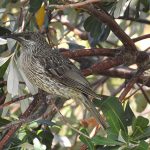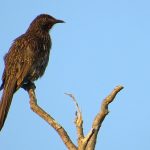LITTLE WATTLEBIRD
The Little Wattlebird is native to south-eastern Australia, including parts of New South Wales, Victoria, South Australia, and Tasmania. It belongs to the honeyeater family (Meliphagidae), a diverse group of Australian birds known for their love of nectar and their unique, brush-tipped tongues for feeding on flowers.
Little Wattlebirds are medium-sized birds, measuring around 28 to 32 cm in length. They have distinctive, long, slender bills that are curved downward. The plumage of the Little Wattlebird is predominantly brown with some white streaks and spots on the underparts. One of their notable features is the patch of bare, wattled skin behind the eye, from which they get their name.
Like other honeyeaters, Little Wattlebirds primarily feed on nectar from various flowers. They use their specialized brush-tipped tongues to extract nectar from flowers. In addition to nectar, they also consume insects and fruits as part of their diet.
Little Wattlebirds are known for their loud and melodious calls. They produce a variety of vocalizations, including harsh chattering sounds and musical notes. These calls are used for communication and to establish territories.
These birds are adaptable and can be found in a range of habitats, including forests, woodlands, heathlands, and gardens. They are often seen near flowering plants where they can access nectar.
Little Wattlebirds are known for their territorial behavior, and they can be quite aggressive when defending their feeding areas. They are solitary birds for much of the year, but they may form small groups during the breeding season.
Little Wattlebirds typically breed from August to December. They build cup-shaped nests in trees or shrubs using twigs, bark, and other plant materials. The female usually lays two to three eggs, and both parents take turns incubating the eggs and feeding the chicks.








